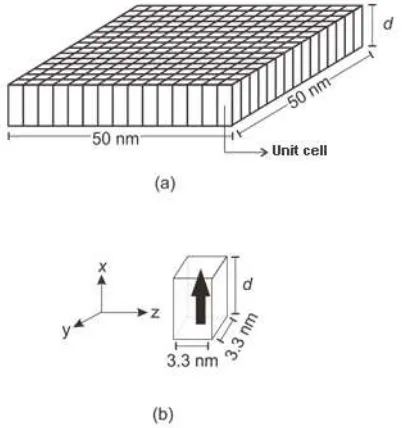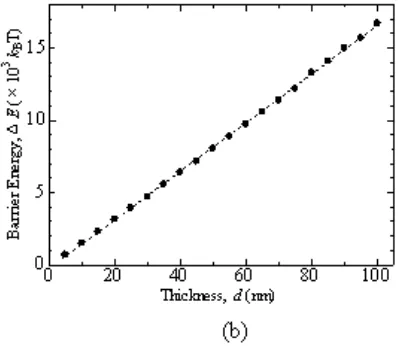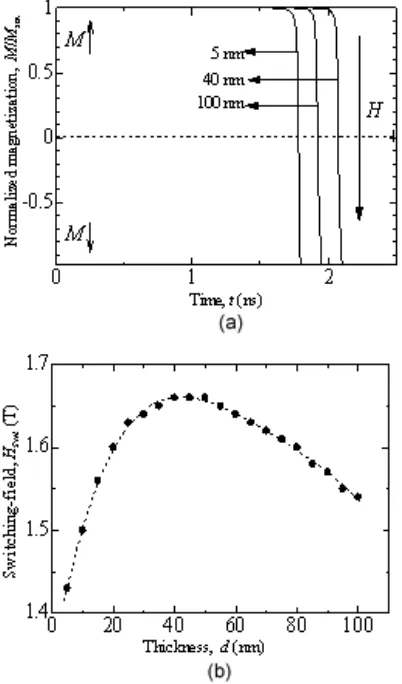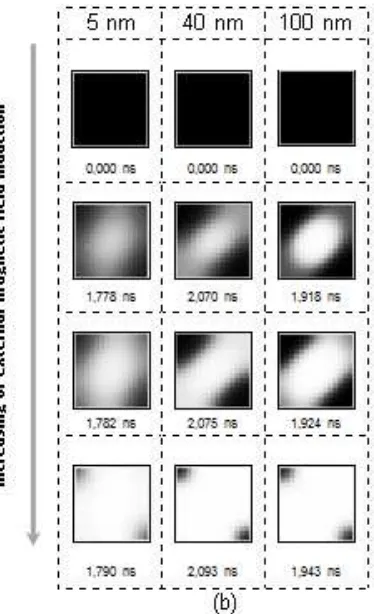e-ISSN 2355-3812
July 2017
DOI: 10.15294/jpi.v13i2.10152
*Correspondence Address: Jalan Diponegoro No.52-60, Salatiga E-mail: [email protected]
http://journal.unnes.ac.id/nju/index.php/jpi
THICKNESS DEPENDENCE OF MAGNETIC SWITCHING
DYNAMICS OF BARIUM-FERRITE AS A HIGH-DENSITY
PERPENDICULAR MAGNETIC STORAGE MEDIA
P. P. Aji1, F. S. Rondonuwu2, N. A. Wibowo1*
1Department of Physics, Universitas Kristen Satya Wacana, Indonesia 2Department of Physics Education, Universitas Kristen Satya Wacana, Indonesia
Received: 17 January 2017. Accepted: 19 June 2017. Published: 1 July 2017 ABSTRACT
Micromagnetic study of material thickness dependence of Barium-ferrite nano-dot magnetization dynamics has been performed. The used materials characteristics in this research represent the properties of Barium-ferrite. Barium-ferrite was modeled as a nano-dot with a surface area of 50 × 50 nm2 and its thickness varies from 5 nm to 100 nm. This nano-dot was simulated using micromagnetic simulator software by solving Landau-Lifshitz-Gilbert equation. According to this study, obtained that the Barium-ferrite nano-dot has excellent thermal stability. Magnetization rate of this nano-dot decreases exponentially with the increase of thickness. The fastest magnetization rate observed in 5 nm of nano-dot thickness, meanwhile 45 nm for the slowest rate. Magnetization reversal mode of this Barium-ferrite nano-dot is dominated by domain wall nucleation and propagation. During the propagation of the domain wall, the exchange interaction becomes the main aspect compared to the other contributed energies.
ABSTRAK
Telah dilakukan studi mikromagnetik pengaruh ketebalan material terhadap dinamika magnetisasi nano-dot Barium-ferit. Karakteristik bahan yang dipergunakan di dalam penelitian ini mewakili karakteristik dari Barium-ferrite. Penelitian ini menggunakan sampel model berbentuk nano-dot berdimensi 50 × 50 nm2 dengan variasi ketebalan 5 nm – 100 nm yang disimulasikan dengan menggunakan software simulator mikromagnetik dengan menyelesaikan persamaan Landau-Lifshitz-Gilbert. Dari simulasi ini diperoleh bahwa Barium-ferit memiliki kestabilan termal yang baik, hal ini dibuktikan dari besarnya nilai energi tanggul. Diperoleh juga bahwa laju magnetisasi bahan cenderung menurun secara eksponensial seiring dengan meningkatnya ketebalan bahan. Laju magnetisasi yang terbesar terjadi pada ketebalan 5 nm dan yang terendah pada ketebalan 45 nm. Pola pembalikan magnetisasi nano-dot Barium-ferit didominasi oleh pembentukan dan perambatan dinding-domain. Pada proses perambatan dinding-domain nano-dot Barium-ferit, interaksi tukar memiliki pengaruh yang lebih besar dibandingkan penyusun energi yang lain.
© 2017 Jurusan Fisika FMIPA UNNES Semarang Keywords: Domain wall; Magnetic ield; Magnetization; Switching ield
Koga, Nozaki, & Matsuyama, 2009) (Liu et al., 2016) and its information would be lost becau-se of low magnetic energy (Ma & Liu, 2008). In overcoming this issues, the uses of perpendi-cular magnetic anisotropy (PMA) material as a storage unit media is required (Waseda et al., 2008) (Alebrand et al., 2012) (Azizah, Trihan-daru, & Wibowo, 2016). The PMA material has
tiny domain-wall which ensures more eicient motion during magnetic ield induction (Jung,
Kim, Lee, Lee, & Lee, 2008) (Woo et al., 2016).
INTRODUCTION
Limitation of scale ratio aspect in meeting the required stability can be solved by utilization of PMA material (Purnama et al., 2009). On the other hand, the magnitude of the driven ield re-quired to reverse the magnetization of the PMA material is too large so that the extended rese-arch on the magnetization dynamics at room temperature should be conducted (Hui, Cheng, Yan, Chen, & Miao, 2015). The magnetization dynamic is related to the external ield either energy which consumed in the magnetization reversal.
The one aspect of this dynamic that im-portant to be investigated is domain wall pro-pagation (Cho, Jung, Cho, & You, 2015). In the last decades, various researchers have focus-ed on the domain wall movement in the PMA thin-ilm (Metaxas et al., 2007; Mihai et al., 2013) which was motivated to understand the fundamental physics role of spintronic based devices (Shepley, Rushforth, Wang, Burnell, & Moore, 2015).
The geometry of ferromagnetic materials signiicantly afects the performance of various magnetic-based devices (Purnama, Prihanto, & Artono, 2013). One important aspect of this geometry is the thickness (Hui et al., 2015). In this paper, media thickness as one factor that controls the magnetization dynamics will be in-vestigated numerically through micromagnetic study. As known from the previous research, media thickness plays an important role in the magnetization reversal which correlated to the read-write data (Hou & Krishnan, 2012) (Zhang, Li, Wang, Nie, & Guo, 2015). The magnetic ma-terial which investigated is Barium-ferrite. The uses of this material have various beneits. Be-side of its large magnetic anisotropy, it also has the chemical stability that assures the durability (Lisi & Lodder, 2002). The strong magnetic ani-sotropy is a fundamental feature required as a magnetic storage media with suicient thermal stability (Shimizu et al., 2012). The purpose of this study is to examine the efect of Barium-ferrite thickness on the magnetization reversal characteristic of switching ield, magnetization rate, and the dynamics of domain wall propa-gation.
METHOD
To solve the magnetization dynamics of Barium-ferrite nano-dot, Equation (1) is used. (Budi Purnama et al., 2009)
eff
This equation called as Landau-Lifshitz-Gilbert (LLG) equation which the irst and sec-ond terms respectively are described the gy-romagnetic motion of magnetization and the damping factor. This damping cause the mag-netization tends to parallel to the efective in-duced magnetic ield. By using LLG equation, magnetization dynamics during exposed to the external magnetic ield can be explained. In this equation, M is the magnetization of the unit-cell, dt is the step integration as large as 0.25 ps, γ is the gyromagnetic ratio as large as 1.76×107 Oe-1s-1 (Lisi, 2002), α is the
Gil-bert damping factor, and Msat is the saturation of magnetization of nano-dot. Hef is the
efec-tive induced magnetic ield which acts as the resultant of a various factor that sourced from the external magnetic ield and internal prop-erties of materials which consist of anisotropy ield (Hk), demagnetization ield (Hd), and ex-change ield (Hex) as given in Eq.(2) (Schrel,
Fidler, Suess, Scholz, & Tsiantos, 2006) (Heri-anto, Rondonuwu, & Wibowo, 2015):
ff
k d ex ext
e
=
+
+
+
H
H
H
H
H
(2)The efective induced magnetic ield which acts as a controller for the magnetic mo-ment is attained from the diferential of energy density, ε, of unit cells with respect to magnetic moment as shown in Eq.(3).
1
In this micromagnetic study, Barium-ferrite was modeled as a parallel-piped which called as nano-dot with the lateral dimension is 50 × 50 nm2 with its thickness varies in the
Figure 1. (a) Nano-dot Barium-ferrite, (b) unit cell (Herianto, Rondonuwu, & Wibowo, 2015)
The chosen intrinsic magnetic properties were magnetic saturation and damping cons-tant as large as 4800 Gauss and 0.9 respec-tively (Boardman, 2005). 6.3×10-7 erg/cm and
3.0×106 erg/cm3 of exchange interaction and
anisotropy constant respectively (Mansuripur & Connell, 1984).
In this study, Reduced Barrier Writing (RBW) simulation scheme was used. This scheme worked at room temperature which there was no contribution of thermal ield. The magnetic ield was exposed to the nano-dot with its magnitude increased linearly from 0 to 2 Tesla for 2.5 ns as shown in Fig.2. Through this scheme, principal information for magnetizati-on reversal dynamics of Barium-ferrite at room temperature can be observed. Either thermal stability of Barium-ferrite or minimum energy that required to reverse the nano-dot magne-tization can be determined. Furthermore, the magnitude of this barrier energy represents thermal stability level of the materials. Low bar-rier energy leads to the unsustainable recorded data in the magnetic storage media. 60 kBT is the minimum barrier energy level should be accomplished in order to store the information more than 10 years (Augustine et al., 2011).
The irst step of this micromagnetic study is to evaluate the magnitude of the barrier ener-gy. After the prerequisite of thermal stability is attained, the second step is to calculate the minimum magnetic ield induction required to exactly switch the magnetic polarization which called as switching ield, Hswt. The magnitude of
Hswt was obtained by inding the magnitude of the ield at which the normalized magnetization equal to zero. The third step is to calculate the magnetization rate. This rate is obtained from the gradient of the normalized magnetization curve.
Figure 2. Reduce Barrier Writing scheme (He-rianto, Rondonuwu, & Wibowo, 2015)
RESULTS AND DISCUSSION
During exposed to the external magnetic ield, the nano-dot has energy which composed from various source. This energy was deined as a scalar summation of the Zeeman energy (Ez), exchange energy (Eex), the magnetic crys-talline-anisotropy energy (EK), and demagneti-zation energy (ED) as shown in Eq.(4).
z ex K D
E
= +
E
E
+
E
+
E
(4)Energy proile of nano-dot for various thicknesses while exposing by external mag-netic ield is given by Fig.3(a). These energies are consisting of the two important values, i.e. maximum and minimum. The peak of this bar-rier energy is achieved at which the magneti-zation of nano-dot is exactly switched. Meanw-hile, minimum energies are the state at which the nano-dot stay in equilibrium. The diference of both values is named as barrier energy, ΔE. This barrier separates the two existing equi-librium state of nano-dot. The irst equiequi-librium state is the condition of nano-dot at initial mag-netization (before induced by external ield). Meanwhile, the second equilibrium state is the condition at which the nano-dot has been magnetized in the induced ield direction. Kno-wledge of about barrier energy is important. It gives the information of the required energy to reverse the magnetization of particular nano-dot. Thickness dependence of energy barrier is shown in Fig.3(b). This barrier highly depends on the thickness of the nano-dot. The energy barrier of the Barium-ferrite nano-dot for va-rious thicknesses are larger than 60 kBT which means this material is compatible to be used as perpendicular magnetic storage media with ex-cellent thermal stability. This barrier is rising li-nearly with respect to the increasing of the me-dia thicknesses. The lowest value is obtained for 5 nm of the thickness with an appropriate barrier as large as 717 kBT. Meanwhile, the lar-gest barrier is observed for 100 nm of the thick-ness with 16.700 kBT of the barrier value.
Figure 3. (a). The energy of Barium-ferrite nano-dot for three diferent thicknesses 5 nm, 40 nm, and 100 nm, (b). The barrier energy of Barium-ferrite nano-dot for various thicknesses at room temperature.
thickness samples, nano-dot with 5 nm of the thickness has the fastest switching time as fast as 1,7825 ns, while the slowest one possessed by nano-dot with 40 nm of thickness as long as 2,0725 ns.
The impression of the nano-dot thick-ness to the magnitude of switching ield is pre-sented in Fig.4(b). For thickness interval 5 nm up to 40 nm, the magnitude of Hswt is magniied from 1.43 T to 1.66 T along with the increasing of nano-dot thickness. Meanwhile, this ield is degraded from 1.66 T to 1.54 T along with the enlarging of the thickness in the range of 40 nm up to 100 nm.
Figure 4. (a) The magnetization reversal of Barium-ferrite nano-dot for three diferent thick-nesses 5 nm, 40 nm, and 100 nm, (b). The switching ield of Barium-ferrite nano-dot for various thicknesses at room temperature.
The impact of the nano-dot thickness to the rate of nano-dot magnetization is shown in Fig.5(a). This rate tends to decrease exponen-tially along with the thickening of the nano-dot. Magnetization rate is highly sensitive to the
thickness in the range of 5 nm up to 50 nm. It means that more required time for thick na-no-dot to be magnetized since its domain wall starts to nucleate. Meanwhile, magnetization rate tends to be constant over 45 nm of the thickness. This magnetization rate information is important for magnetic storage application which correlated to the eiciency of data recor-ding. With fast magnetization rate, the utilizati-on of this magnetic recording more eicient in time either energy consumption.
Figure 5. (a). The thickness dependence of the magnetization rate of the Barium-ferrite nano-dot for various thicknesses at room tempera-ture, (b). The visualization of magnetization reversal of Barium-ferrite nano-dot for three dif-ferent thicknesses 5 nm, 40 nm, and 100 nm during induced by external magnetic ield.
CONCLUSION
Thickness dependence of the magne-tization dynamics for Barium-ferrite nano-dot has been investigated using Landau-Lifshitz-Gilbert equation. As a result, the Barium-ferrite nano-dot has the excellent thermal stability which represented by its high barrier energy (> 60 kBT) for entire the chosen thicknesses. Tem-porarily, the magnitude of the switching ield reaches its maximum value at 40 nm of thick-ness then decrease along as the thickening of nano-dot. This switching ield reduction is follo -wed by the increasing of thermal stability level. Moreover, the fastest and slowest magnetizati-on rates are observed for 5 nm and 45 nm of the thicknesses respectively. The magnetizati-on reversal mode is dominated by domain wall nucleation and propagation which exchange interaction takes more noteworthy control than another contributed energies.
ACKNOWLEDGMENTS
This research was supported by Satya Wacana Christian University through Internal Funding 2016.
REFERENCES
Alebrand, S., Gottwald, M., Hehn, M., Steil, D., Cinchetti, M., Lacour, D., … Mangin, S. (2012). Light-induced magnetization reversal of high-anisotropy TbCo alloy ilms. Applied Physics Letters, 101(16), 162408.
Augustine, C., Raychowdhury, A., Behin-Aein, B., Srinivasan, S., Tschanz, J., De, V. K., & Roy, K. (2011). Numerical analysis of domain wall propagation for dense memory arrays (p. 17.6.1-17.6.4). IEEE.
Azizah, U. M. N., Trihandaru, S., & Wibowo, N. A. (2016). Micromagnetic study of exchange interaction efect on magnetization reversal mode of CoFeAl (p. 030014).
Cho, J., Jung, J., Cho, S.-Y., & You, C.-Y. (2015). Efect of annealing temperature on exchange stifness of CoFeB thin ilms. Journal of Mag-netism and Magnetic Materials, 395, 18–22. https://doi.org/10.1016/j.jmmm.2015.06.073 Herianto, N. A., Rondonuwu, F. S., & Wibowo, N. A.
(2015). Damping Dependence of Reversal Magnetic Field on Co-based Nano-Ferro-magnetic with Thermal Activation. Smart Sci-ence, 3(1), 16–20. https://doi.org/10.1080/23 080477.2015.11665632
Hou, Y., & Krishnan, K. M. (2012). Thickness-de-pendent magnetization reversal behavior of lithographic IrMn/Fe ring structures. Journal of Applied Physics, 111(7), 07B905. https:// doi.org/10.1063/1.3672827
Hui, Y., Cheng, W., Yan, P., Chen, J., & Miao, X. (2015). Thickness dependence of magnetic properties in La?Co substituted strontium hexaferrite ilms with perpendicular anisotro-py. Journal of Magnetism and Magnetic Ma-terials, 390, 56–60. https://doi.org/10.1016/j. jmmm.2015.04.081
Jung, S.-W., Kim, W., Lee, T.-D., Lee, K.-J., & Lee, H.-W. (2008). Current-induced do-main wall motion in a nanowire with per-pendicular magnetic anisotropy. Applied Physics Letters, 92(20), 202508. https://doi. org/10.1063/1.2926664
Kim, C., Loedding, T., Jang, S., Zeng, H., Li, Z., Sui, Y., & Sellmyer, D. J. (2007). FePt nanodot arrays with perpendicular easy axis, large coercivity, and extremely high density. Ap-plied Physics Letters, 91(17). https://doi. org/10.1063/1.2802038
sta-bility enhancement in a perpendicular MgO/ CoFeB/W/CoFeB/MgO recording frame.
Sci-entiic Reports, 5(1). https://doi.org/10.1038/
srep16903
Krone, P. (2011). Magnetization Reversal Processes of Nanostructure Arrays (Dissertation). Re-trieved from http://www.qucosa.de/recher-che/frontdoor/?tx_slubopus4frontend%5bid %5d=urn:nbn:de:bsz:ch1-qucosa-71358 Lisi, A., & Lodder, J. C. (2002). Relation between
the microstructure and magnetic properties of BaFe12O19 thin ilms grown on various sub-strates. Journal of Magnetism and Magnetic Materials, 242–245, Part 1, 391–394. https:// doi.org/10.1016/S0304-8853(01)01233-1 Liu, Y., Yu, T., Zhu, Z., Zhong, H., Khamis, K. M., &
Zhu, K. (2016). High thermal stability in W/ MgO/CoFeB/W/CoFeB/W stacks via ultra-thin W insertion with perpendicular magnetic anisotropy. Journal of Magnetism and Mag-netic Materials, 410, 123–127. https://doi. org/10.1016/j.jmmm.2016.02.099
Ma, Y., & Liu, B. (2008). Lube Depletion Caused by Thermal-Desorption in Heat Assisted Magnetic Recording. IEEE Transactions on Magnetics, 44, 3691–3694. https://doi. org/10.1109/TMAG.2008.2001670
Mansuripur, M., & Connell, G. A. N. (1984). Energet-ics of domain formation in thermomagnetic recording. Journal of Applied Physics, 55(8), 3049. https://doi.org/10.1063/1.333298 Metaxas, P. J., Jamet, J. P., Mougin, A., Cormier,
M., Ferré, J., Baltz, V., … Stamps, R. L. (2007). Creep and Flow Regimes of Mag-netic Domain-Wall Motion in Ultrathin Pt / Co / Pt Films with Perpendicular Anisotropy.
Physical Review Letters, 99(21). https://doi.
org/10.1103/PhysRevLett.99.217208 Mihai, A. P., Whiteside, A. L., Canwell, E. J.,
Mar-rows, C. H., Benitez, M. J., McGrouther, D., … Moore, T. A. (2013). Efect of substrate temperature on the magnetic properties of epitaxial sputter-grown Co/Pt. Applied Phys-ics Letters, 103(26), 262401. https://doi. org/10.1063/1.4856395
Purnama, B., Koga, M., Nozaki, Y., & Matsuyama, K. (2009). Stochastic simulation of thermally assisted magnetization reversal in sub-100 nm dots with perpendicular anisotropy. Jour-nal of Magnetism and Magnetic Materials, 321(9), 1325–1330. https://doi.org/10.1016/j. jmmm.2008.12.003
Purnama, B., Prihanto, H. S. B. R., Artono, D. S.
(2013). Karakteristik Magnetik Lapisan Tipis Ni-Fe Sebagai Flat Core Flux Gate Sensor. Jurnal Pendidikan Fisika Indonesia, 9(2). https://doi.org/10.15294/jpi.v9i2.3039 Sadnawanto, W., -, C., & Purnama, B. (2014).
Modi-ikasi Model Thermally Pada Heat Assisted Magnetisasi Reversal Nano Partikel Magne-tik. Jurnal MIPA, 37(2), 136–140.
Schrel, T., Fidler, J., Suess, D., Scholz, W., & Tsian-tos, V. (2006). Micromagnetic Simulation of Dynamic and Thermal Efects. In Y. Liu, D. J. Sellmyer, & D. Shindo (Eds.), Handbook of
Advanced Magnetic Materials (pp. 128–146).
Boston, MA: Springer US. Retrieved from http://link.springer.com/10.1007/1-4020-7984-2_4
Shepley, P. M., Rushforth, A. W., Wang, M., Burnell, G., & Moore, T. A. (2015). Modiication of per-pendicular magnetic anisotropy and domain wall velocity in Pt/Co/Pt by voltage-induced strain. Scientiic Reports, 5, 7921. https://doi. org/10.1038/srep07921
Shimizu, O., Murata, Y., Kurihashi, Y., Harasawa, T., Asai, M., Sueki, M., & Noguchi, H. (2012). Long-Term Archival Stability of Barium Fer-rite Magnetic Tape. Journal of the Magnetics Society of Japan, 36(1_1), 1–4. https://doi. org/10.3379/msjmag.1112R001
Waseda, K., Doi, R., Purnama, B., Yoshimura, S., Nozaki, Y., & Matsuyama, K. (2008). Heat-Assisted Magnetization Reversal Us-ing Pulsed Laser Irradiation in Patterned Magnetic Thin Film With Perpendicular An-isotropy. IEEE Transactions on Magnetics, 44(11), 2483–2486. https://doi.org/10.1109/ TMAG.2008.2003068
Woo, S., Litzius, K., Krüger, B., Im, M.-Y., Caretta, L., Richter, K., … Beach, G. S. D. (2016). Ob-servation of room-temperature magnetic sky-rmions and their current-driven dynamics in ultrathin metallic ferromagnets. Nature Mate-rials, 15(5), 501–506. https://doi.org/10.1038/ nmat4593
Wood, R. (2009). Future hard disk drive sys-tems. Journal of Magnetism and Magnetic Materials, 321(6), 555–561. https://doi. org/10.1016/j.jmmm.2008.07.027



